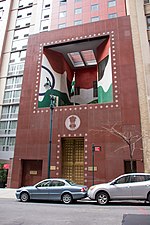Costello's (also known as Tim's) was a bar and restaurant in Midtown Manhattan, New York City, from 1929 to 1992. The bar operated at several locations near the intersection of East 44th Street and Third Avenue. Costello's was known as a drinking spot for journalists with the New York Daily News, writers with The New Yorker, novelists, and cartoonists, including the author Ernest Hemingway, the cartoonist James Thurber, the journalist John McNulty, the poet Brendan Behan, the short-story writer John O'Hara, and the writers Maeve Brennan and A. J. Liebling. The bar is also known for having been home to a wall where Thurber drew a cartoon depiction of the "Battle of the Sexes" at some point between 1934 and 1935; the cartoon was destroyed, illustrated again, and then lost in the 1990s. A wall illustrated in 1976 by several cartoonists, including Bill Gallo, Stan Lee, Mort Walker, Al Jaffee, Sergio Aragonés, and Dik Browne, is still on display at the bar's final location.
The bar was founded in 1929 as a speakeasy on Third Avenue by brothers Tim and Joe Costello, who had emigrated to the United States from Ireland. Tim was known as an affable, intelligent proprietor with an interest in literature. In the early 1930s, the bar moved to the corner of East 44th Street and Third Avenue, before moving one door away on Third Avenue in 1949. The bar moved to its final location at 225 East 44th Street in 1974. Costello's closed in 1992; the Turtle Bay Café took over the space, operating until 2005. Since then, the location has been occupied by a sports bar called the Overlook. The bar is remembered through the stories that have been told about it over the years. The writer John McNulty is credited with creating a mythology around Costello's—which he called "this place on Third Avenue"—through a series of short stories published in The New Yorker in the 1940s.








